M.S.
Use Google Chrome
for this web page to load perfectly!
Click the logo above to reach the ssMaritime FrontPage for Ships of the Month & News Updates
With
Maritime Historian, Cruise‘n’Ship Reviewer, Author & Lecturer
Please Note: All ssmaritime as well as my other related
maritime & cruise sites are 100% non-commercial and privately owned sites.
Be assured that I am NOT associated with any shipping or cruise companies or
agencies or any other organisations! The author has been in the passenger
shipping industry since May 1960, but although retired and unwell, I
occasionally attempt to write an article now and then, in order to bring
enjoyment and pleasure to ship enthusiasts past passengers and crew.
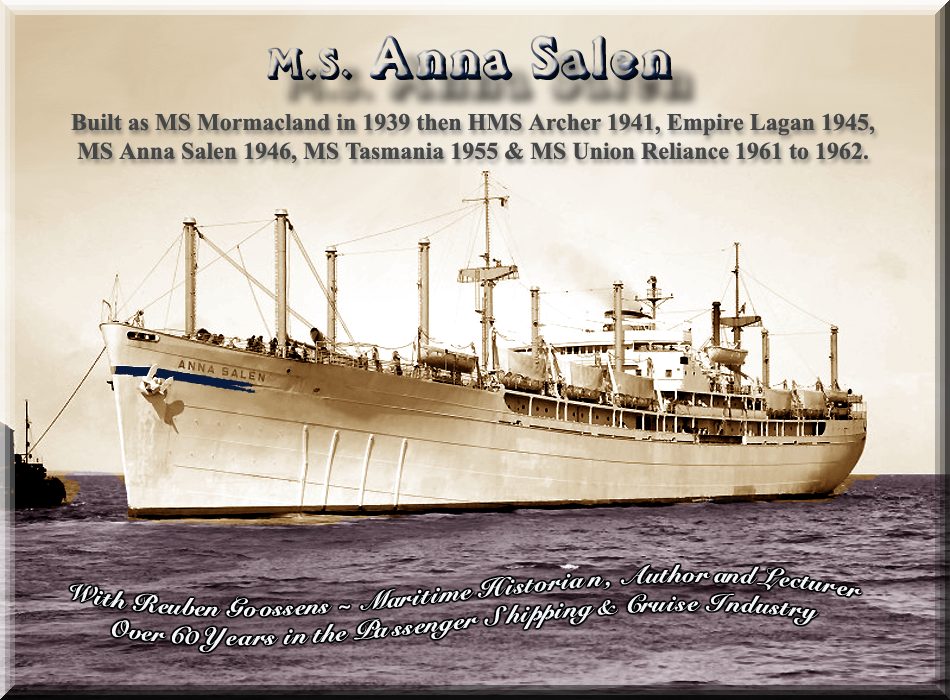
Later M.S. Tasmania
& M.S. Union Reliance
Introduction:
Page One, will commenced with the very
beginning of the ship that became the M.S. Anna Salen, as she was built as the
12 passenger cargo liner the
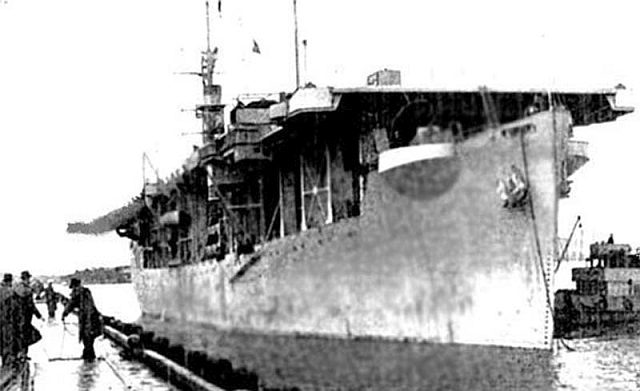
The
last known photo of the Empire Lagan seen in Auckland New
M.S. Anna Salen
Thus the hideous boxy looking ship was
purchased by
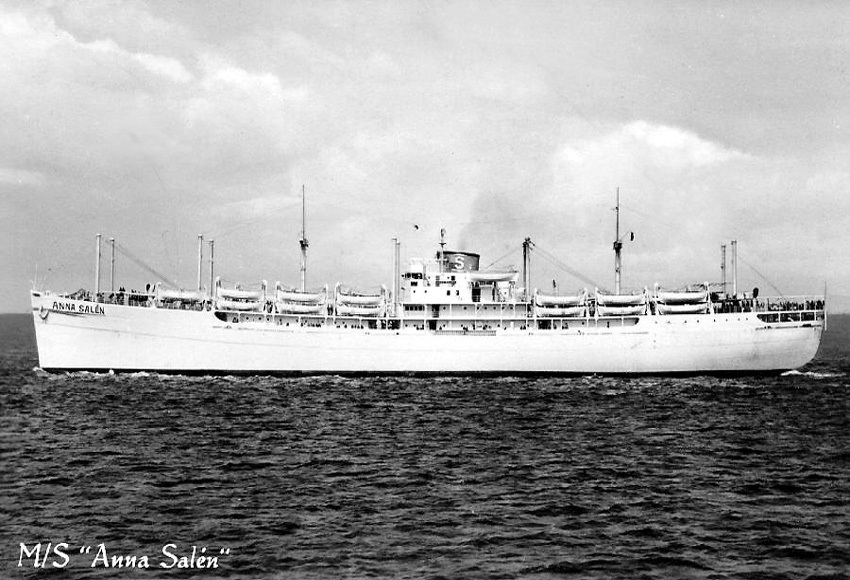
However, considering Mr. Salén obtained a contract from the “International Refugee Organization” (IRO) to transport displaced persons to various parts of the world, he advised Bethlehem Shipyard to change plans and rebuilt into a basic migrant ship were the accommodation for up to 1,500 persons, which would be installed, in the huge open spaces of her holds with no actual fixed beds as such, but these were all triple-decker bunks, and the upper bunk would lower on top of the middle bunk during the day, these bunks were very cramped, so much so you were unable to sit up in them. There were some smaller four, six to eight bedded cabins on B and C Decks, as well as one smaller cabin on D Deck for special families. See the Passenger Deck Plan for details.
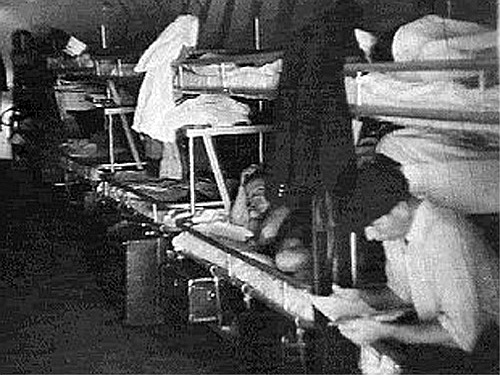
This is the men’s bunk hold, note the top bunks
Men would be assigned to one to their holds, with women and children to other. There was also a large open toilet and washing block. Up on A Deck there were two specious open air decks for the passengers to enjoy fresh air and some sunshine, there were the “Aft” and “Fore Decks”, whilst on B (Shelter) Deck there was a short narrow covered promenade deck. The main superstructure above was completely out of bounds to all passengers, as the area was for the crew only! Thus all passenger facilities and accommodations was located in the hull and generally there were no portholes or a view out to the sea, except one public venue which had three portholes.
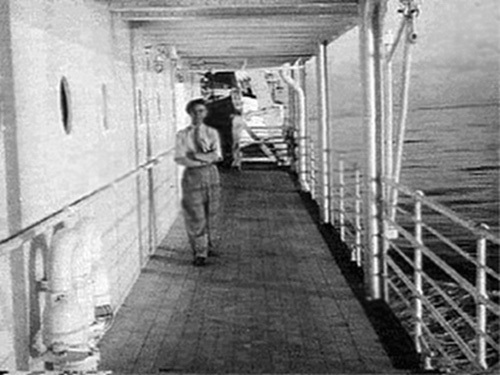
Here we see the B (Shelter) Deck promenade deck, with an unknown passenger
Photograph from an unknown source; Please see photo notes at the bottom of the page
Also on B Deck far aft of the central superstructure was the Information Desk, and the hospital, Medical center just aft on the starboard side.
Down in the hull amidships on the starboard side was the “Grüner Salon” or the Green Lounge and Bar being the only area with three portholes. Whilst far aft was a spacious “Dancing Room” and Snack Bar. Amidships and D and E decks were the large interior Dinning Rooms.
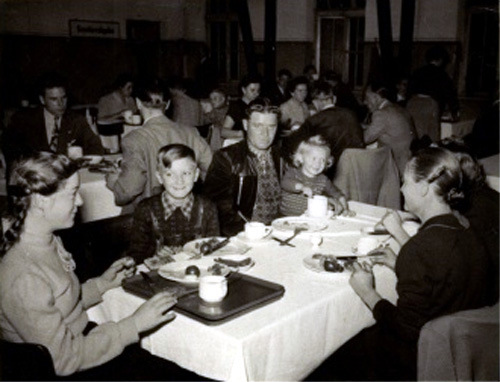
One of the Dining Rooms where families would be able to gather
Dinning times were as follows: Passengers had to be seated for Breakfast 8 to 9 am. Lunch 12 noon to 1 pm, Evening meal 5.30 to 6.30 pm. A special daily children’s sitting in the Upper Dining Room was at 3 pm
Deck
Plan
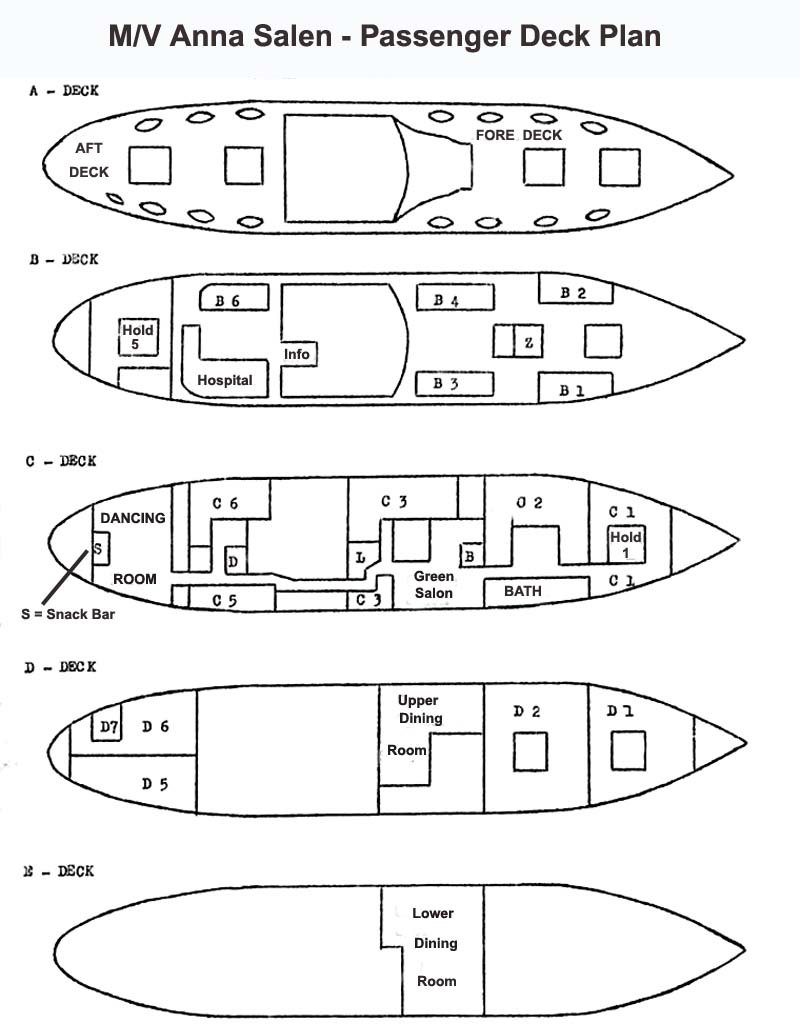
M.S. Anna Salen
After a long refit and rebuild, she was
finally completed and the
She was ready to commence in her new role as a
rather humble full time immigrant ship, and in 1949 she finally sailed from
However, most of her voyages back to
As many regular readers of ssMaritime know
well, I have covered countless ships that transported large numbers of European
displaced persons that settled either in
IRO Voyages to Australia Naples Italy
Voyage One: The
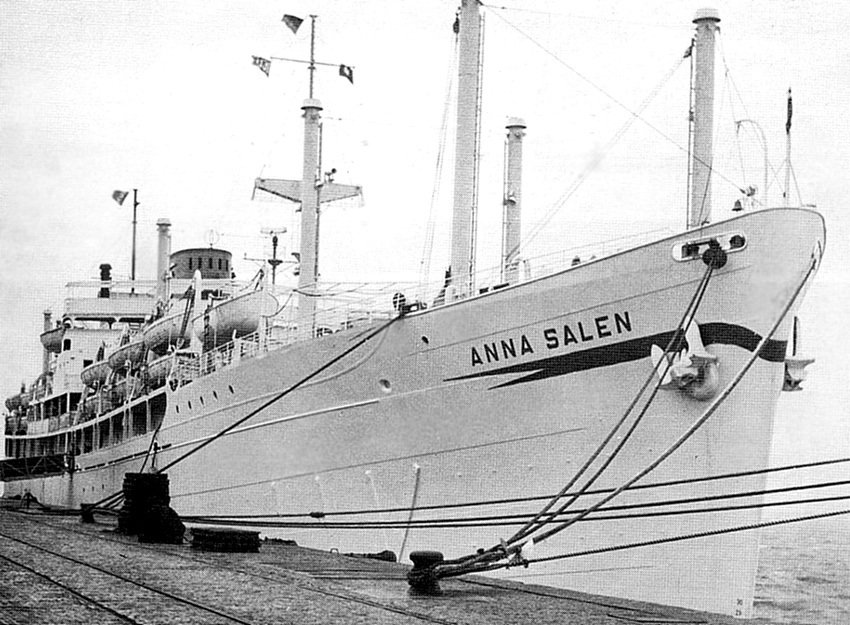
A
fine bow view of the
Voyage Two:
also departed from
A Voyage filled with malnourished and ill Passengers and Children:
Voyage Three: departed Naples on October two, 1949 and this would be come a voyage that would receive a huge amount of publicity when she arrived in Melbourne on October 30, and she was quarantined and the ship had to anchor in Port Phillip Bay, due to deaths of 6 poor children and 114 others on board from measles, even the pilot had to remain on board until the ship was permitted to berth for Doctors to be able to carry out quarantine examinations of the pilot and all passengers and the ships crew.
Please Note: On
Page Three there are a number of news Paper Reports for you to read and they
are very interesting, as they explain how
Break Down on the Indian
Ocean
Voyage Four: On
December 1, 1949 the
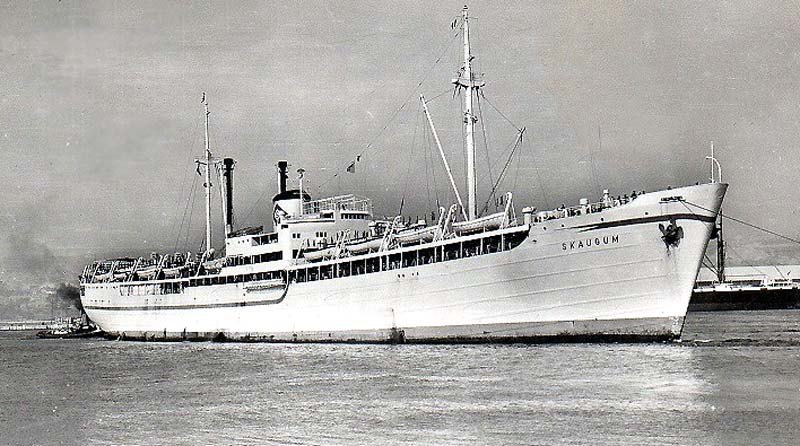
The
The “Skaugum”, was a very similar
ship, also operating with much the same type of accommodations with berths
fitted in her holds, etc. Upon her arrival in
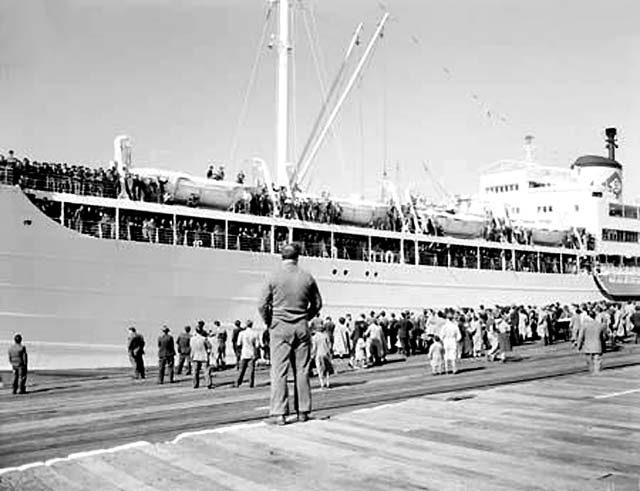
Large
crowds have come to see the many on board as the Skaugum arrives back in
The
New Home Port Bremerhaven Germany
Voyage Five:
A Newsletter Provided to Embarking passengers:
Please Note:
The Newsletter below is a translation from German and several other Eastern
European languages.
To all Passengers:
We bid all passengers onboard the “
Management of Ship.
Important Announcements for the Day of Departure:
Evening mealtime today is 6 p.m. to 7 p.m. Tonight from 8 p.m. to 9 p.m. vouchers can be redeemed for the ship’s currency at the Snack Bar in the Dance Hall. From 8 p.m. to 10 p.m. the Drug Store will be open for the sale of cigarettes. It was already pointed out today that the onboard currency must be spent during the voyage and cannot be returned.
During the voyage please especially comply with:
The passengers are requested to leave their cabins every morning, immediately after having made your beds, and stay away while the stewards are busy with cleaning. During the time from 10 to 11 before noon there will be a daily inspection during which all passengers are to be absent from the cabins. Quiet on the ship commences evenings at 11 p.m. At 11.15 p.m. is the nigh time inspection. Please conduct yourself quietly on board from 11 p.m., consider the mothers with children as well as the passengers who wish to sleep. Except for fruit do not take any food out of the cafeteria. Food found in cabins will be destroyed. Blankets belonging to the ship as well as cutlery and cabin fittings are not to be taken on deck. Pay attention to announcements on the notice board in the Green Salon as well as messages via the loudspeaker.
For special attention - VERY IMPORTANT:
Passengers with children should upon coming onboard ensure that life jackets are available for the children. Ask your steward or your stewardess about children’s life jackets. During ship drills, as well as in an emergency, all passengers should gather at life-boat stations as announced in the dormitories — and under no circumstances at the lifeboats. Inform yourself in advance about the location applicable to you.
***********************************
Voyage Six:
The Canadian Services:
Return
to the Australian Service:
The
Helsinki
Collision with a Whale Factory Ship:
However, having completed her ferry duties,
she was booked to sail to
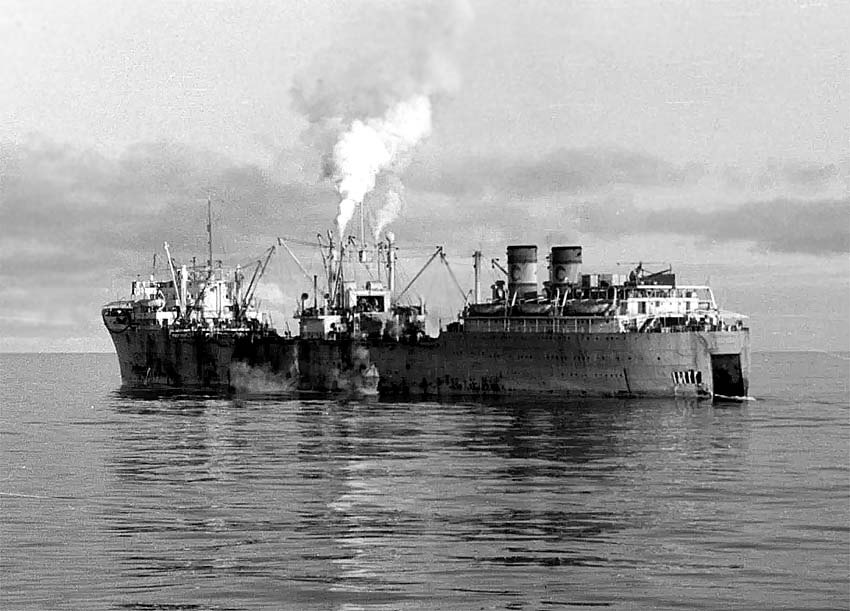
The
Whaling Factory Ship
At the time there was thick fog at the time
and both ships suffered damage, but the

The “Thorshovdi”
headed to “Burmeister & Wain Engineering” in
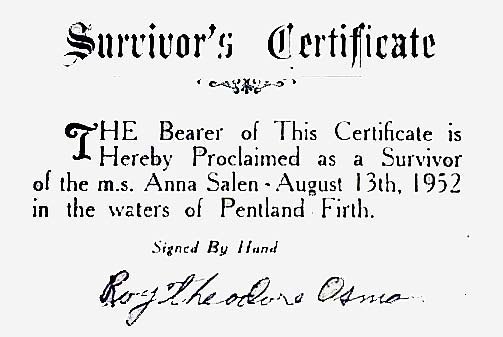
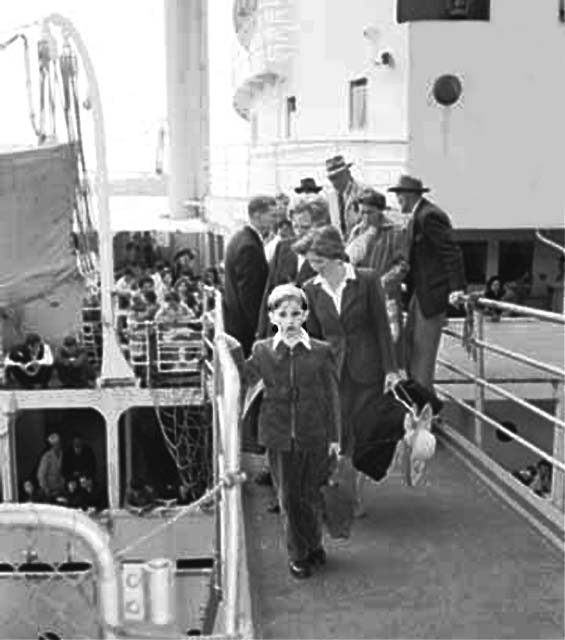
Passengers
are seen disembarking the
Photograph
with thanks from the “National Archives of Australia”
M.S. Tasmania:
The
The new look M.S.
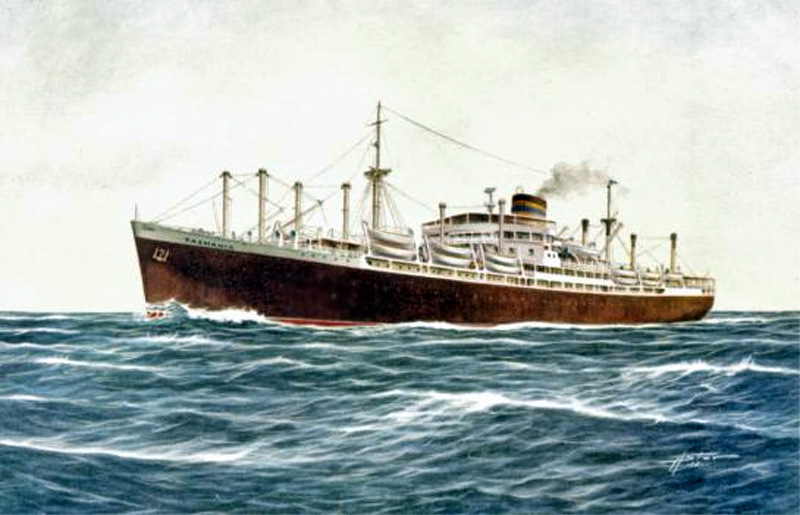
A Hellenic Mediterranean Line pre-release postcard of the M.S. Tasmania
The
She continued her voyages to Australia however whilst entering Port Philp Bay to Melbourne on April 3, 1956 she suddenly ran aground and she suffered some damage to the bottom of her hull. She did mange to reach her berth and all passengers disembarked, but she required repairs and this delayed her departure by around eleven days.
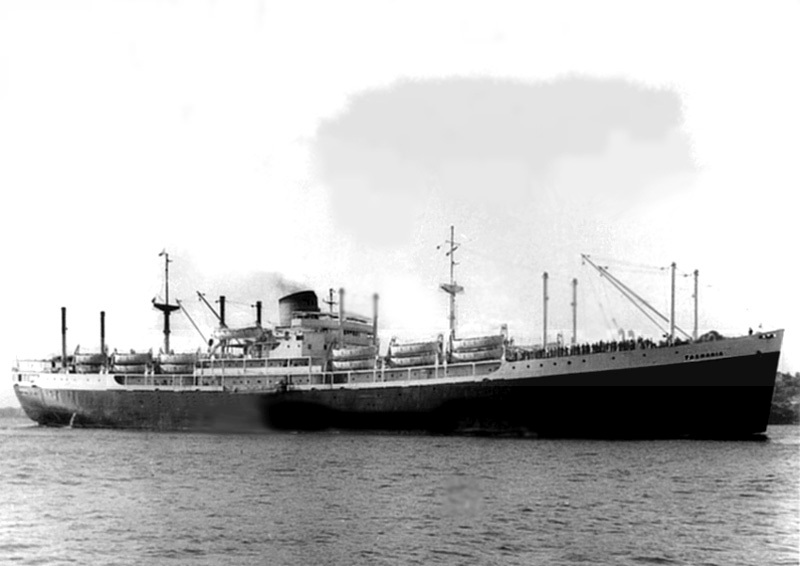
An actual photograph of the M.S. Tasmania
M.S. Tasmania arrived in departed
Upon arriving in
The tragic M.S Union Reliance:
Please
Note: I am sorry,
but to date I have not been able to locate any images of the M.S. Union
Reliance.
Early in
1961, the
However, it
was her old age as well as being a worn ship, but more so poor maintenance that
finally caught up with her, when she broke down at the very worst possible time
whilst under Taiwanese ownership she became a neglected ship and was operated
by an incompetent captain and crew.
The ship was
found to be in need of extensive engine room repairs due to extensive wear.
Repairs were made to the engine controls in
The Union
Reliance headed to Taiwan, where additional repairs were to be made, before
proceeding with general cargo bound for Japan and then onto the United States.
She was given the five piston heads desperately needed for her engines upon
arrival in
The ship
proceeded through the Panama Canal and arrived in
She then
departed
Steering the
Union Reliance wasn’t the only problem – the telephone
communication system between the bridge, engine room and steering engine room
was inoperative. A Coast Guard enquiry later found that “it was difficult
to hear over the ship’s telephone system, and that it was necessary to
use messengers from the bridge to relay any emergency messages to the engine
room.”
Then, at
around 11.10 pm, whilst approaching a bend in the channel, pilot
The engines
were ordered full astern and the danger signal was sounded on the ship’s
whistle, after which pilot Duncan ordered both anchors to be dropped. All four
engines had been coupled to run ahead for maximum speed. Upon receiving orders
from the bridge for full power astern, “the engine room reversed one set
of two engines, and coupled same to the propeller shaft to give astern
power.” Capt. Charles Lary, the Houston Ship
Channel pilot on board the “Berean”, immediately blew three blasts
in return to show that he recognized the emergency, ordered full speed astern and
gave the Berean hard-right rudder in order to run the ship aground in the mud
on the side of the channel.
The Union
Reliance sheered across the channel, where her bow made contact with the port
side of the Berean, penetrating ten feet into the Berean’s
number one cargo hold. The hold contained acrylonitrile,
being a vinyl cyanide flammable material that gives off dangerous fumes similar
to cyanide poisoning. The toxic liquid sprayed over the forward half of the
Union Reliance and touched off a fire that consumed the forward section of the
ship up to the deck house and continued aft to the stern. The fire spread so
fast that only one aft starboard side lifeboat could be launched, taking 23
crew members aboard. They picked up the ship’s captain after he jumped
off the bridge into the water.
The
remaining crew members on the Union Reliance were successful in extinguishing
smaller fires aft, but they were unable to fight the main larger fire forward
being due to fire hose couplings having different threads they simply could not
fit all the fire hydrants.”
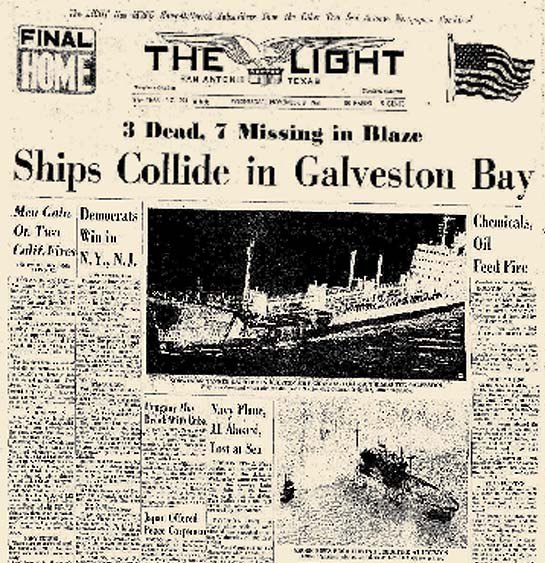
Thankfully,
there were no injuries or lives lost on the Berean, although she did sustain
extensive damage to her hull. The Union Reliance continued burning for several
days; and she blocked the channel until November 10,
when she was finally towed to, and anchored in Galveston Harbour (arriving on
the 11th), by the “United States Corps of Engineers”, but the fire
had completely gutted her.
The Coast
Guard inquiry after the collision ruled that “there was no negligence on
the part of either the
Please
Note: On there is
a link on Page Three for you to read a nine page pdf
transcript of the “Coast Guard inquiry” - Final Reviews and results
re the Inquiry, who clearly states who was to blame!
The Union
Reliance was completely abandoned by her owners and China Union Lines, who also
refused to make any payment to the
At the Breakers Yards:
Finally it
was on January 12, 1962, that the wreck of the Union Reliance was sold to be
scrapped for US$109,100.72. However, she was completely destroyed by yet
another fire on February 19, 1962, during her being dismantled at a New Orleans
Shipyard, but her breaking up was completed late in March 1962.
In conclusion:
Ships:
Built by:?????????????????????????????????????????? Sun
Shipbuilding & Drydock Co.,
Yard:?????????????????????????????????????????????? 184.
Launched:???????????????????????????????????????? December
14, 1939 as the Mormacland.
Tonnages:??????????????????????????????????????? 11,762
GRT -
.????????????????????????????????????????????????????? 7,368
GRT -
Length:??????????????????????????????????????????? 494 ft - 150.5 m.
Beam:????????????????????????????????????????????? 69.2 ft - 21.1 m.
Draught:?????????????????????????????????????????? 29.1 ft - 8.86 m.
Propulsion:?????????????????????????????????????? 4 × 7 cylinder SCSA diesel engines (Busch-Sulzer Bros Diesel Engine Co, St Louis) 2,060 HP (1,540 kW) each, driving a large single screw through electro-magnetic couplings and single reduction gearing.
Speed:???????????????????????????????????????????? Service speed 15.5 knots, maximum 17.5 knots.
Range:???????????????????????????????????????????? 14,550 nautical miles (26,950 km) at 10 knots.
Passengers:????????????????????????????????????? 1,550
including children on the
.????????????????????????????????????????????????????? None - Union Reliance.
1948:??????????????????????????????????????????????
1955:??????????????????????????????????????????????
1961:??????????????????????????????????????????????
Fate:?????????????????????????????????????????????? Scrapped in
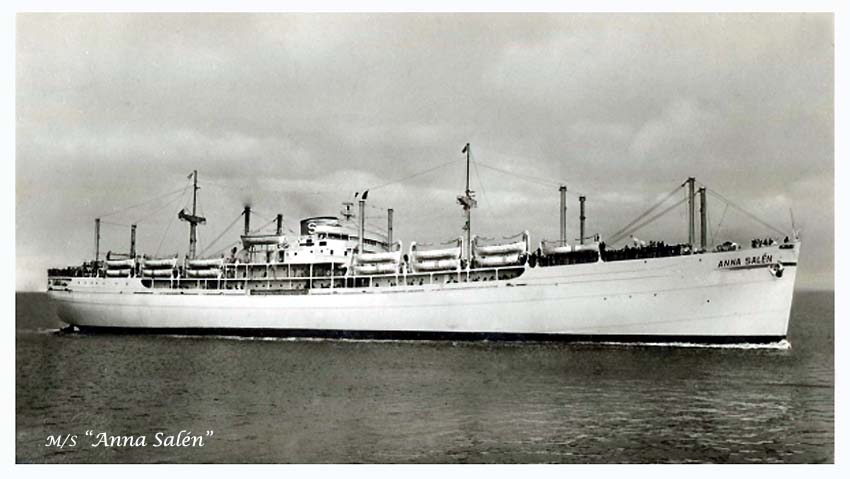
This is how the vast majority of migrants who sailed on this ship will remember her
As
the
Page One
…?????????? History of
Page Two
… ????????? History of the
Page Three
…??????? 1.
.??????????????????????????? 2.
Union Reliance, a pdf “Coast Guard
inquiry” who was to blame of the collision between her and the M/V Berean.
Depart
Use
this Link … M.S. Anna Salen Fremantle
Dec 31 50
***********************************
?“Blue Water Liners
sailing to the distant shores.
I watched them come, I watched them go and I watched them die.”
ssMaritime.com & ssMaritime.net
Please Note:
ssmaritime and associated sites are 100% non-commercial and the author seeks no funding or favours of any shape or form, never have
and never will!
Photographs on ssmaritime and associate pages are: by the author or from the author’s private collection. In addition there are some images that have been provided by Shipping Companies and private photographers or collectors. Credit is given to all contributors. However, there are some photographs provided to me without details regarding the photographer/owner concerned. I hereby invite if owners of these images would be so kind to make them-selves known to me (my email address may be found on www.ssmaritime.com only), in order that due credit may be given.
This notice covers all pages:
although, and I have done my best to ensure that all photographs are duly
credited and that this notice is displaced on each page, that is, when a page
is updated!
